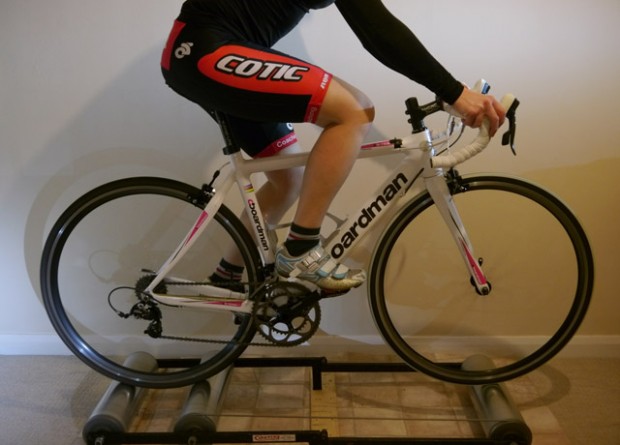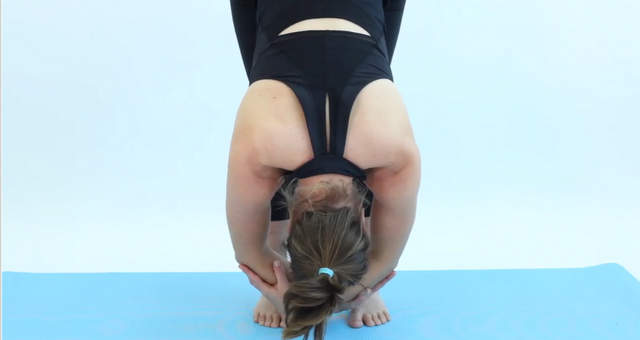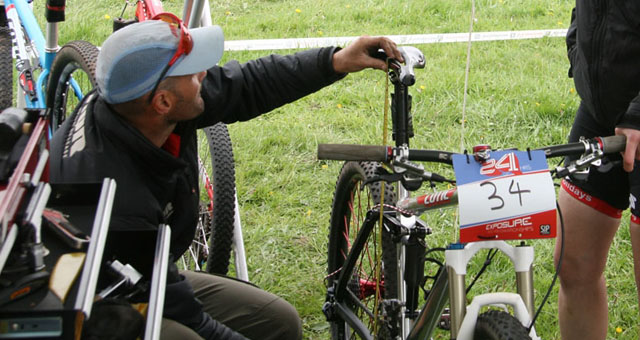There are going to be some days over the coming months where you just can’t go outside to cycle. It’s sad, but unfortunately true. Whether it’s too dangerous because of icy roads, you can’t face getting soaked again or you’re pushed for time, training indoors is the perfect solution.

You can choose between rollers or a turbo trainer (more on those later) and over the next couple of weeks we’ll run through what they are, how to choose which one and how to get the best from them.
What are rollers and how do they work?
Rollers are essentially three drums, attached to two parallel rails. The front wheel of your bike rests on the foremost roller, which in turn is attached to the rear two rollers by a giant elastic band; your rear wheel sits on these two.
Unlike a turbo trainer there are no clamps to hold your bike in place, you must pedal to keep the bike and yourself upright. Don’t panic, it is not as difficult as you think to get enough momentum to stay in the saddle on rollers.

Admittedly, for this reason rollers are harder to use than a turbo trainer, as you have to use your core muscles to balance and handle the bike to use them. However, once you have mastered the roller technique they will prove to be invaluable, offering a more ‘realistic’ ride, even though you’re in the comfort of your own home.
As you need to put thought and concentration into what you’re doing on rollers, time flies when you’re working out, and it can also help improve your overall riding technique. You will find that your pedalling style becomes much, much smoother. Jerky pedal strokes become magnified and can unsettle your balance, so you’re likely to end up pedalling off the rollers and into the wall/table/cat/television.
Rollers generally rely on the bikes gearing to provide resistance so it’s best to have a bike with smooth tyres. Knobbly tyres on rollers leads to a very unpleasant experience – just trust us on this one. If you are thinking about competing they are also an excellent portable way of warming up.
What to look out for when buying rollers
There are three main types of roller to choose from which tend to fall into similar price brackets. The majority are either hinged or collapsible for easy transportation and storage.
Budget: £100 – £150
Beginner rollers tend to have a plastic drum, which won’t roll quite as quickly as others. The individual rollers themselves are often elliptical or parabolic in shape, think bobbin-shaped and this is to help keep you in the centre, rather than riding off the edges.
Tacx Antares, Elite Ghibli Parabolic and Minoura all fall into this category and you should expect to pay around the £100 – £150 mark.
Budget: £200 – £250
Intermediate rollers tend to be flat or very slightly concave so you lose the little safety bumpers. Some such as CycleOps and Jet Black come with aluminium drums giving much less resistance between tyre and roller creating a faster and smoother action. An intermediate roller such as this will cost around £230, other models include the Tacx Galaxia.
Budget: £250+
Similar to intermediate in roller style but with the addition of magnetic resistance built into the rollers allowing harder sessions to be carried out. In most cases the resistance is housed in the middle roller and has three settings, it doesn’t have a remote switch so would need to be set before the session.
If you already have a turbo or are planning on purchasing one then this may not be a feature that you would ever use as many people find the gears on their bikes suitable to provide enough resistance.
Prices begin at around £280 and models to look at include the CycleOps aluminium with resistance and the Elite Arion range.
Budget: There is no budget…
For a cool £700 you can have a set of E-motion rollers from Elite. These rollers have three resistance settings but are set within a subframe so they float and move about with the bike, making them much more stable and even possible to do out of the saddle efforts!
Enjoy sourcing your new training buddy, before long you’ll be as proficient at rolling as this lady is…
In Bev’s next post she’ll share how to set up your newly acquired rollers and get rolling, rolling, rolling…





